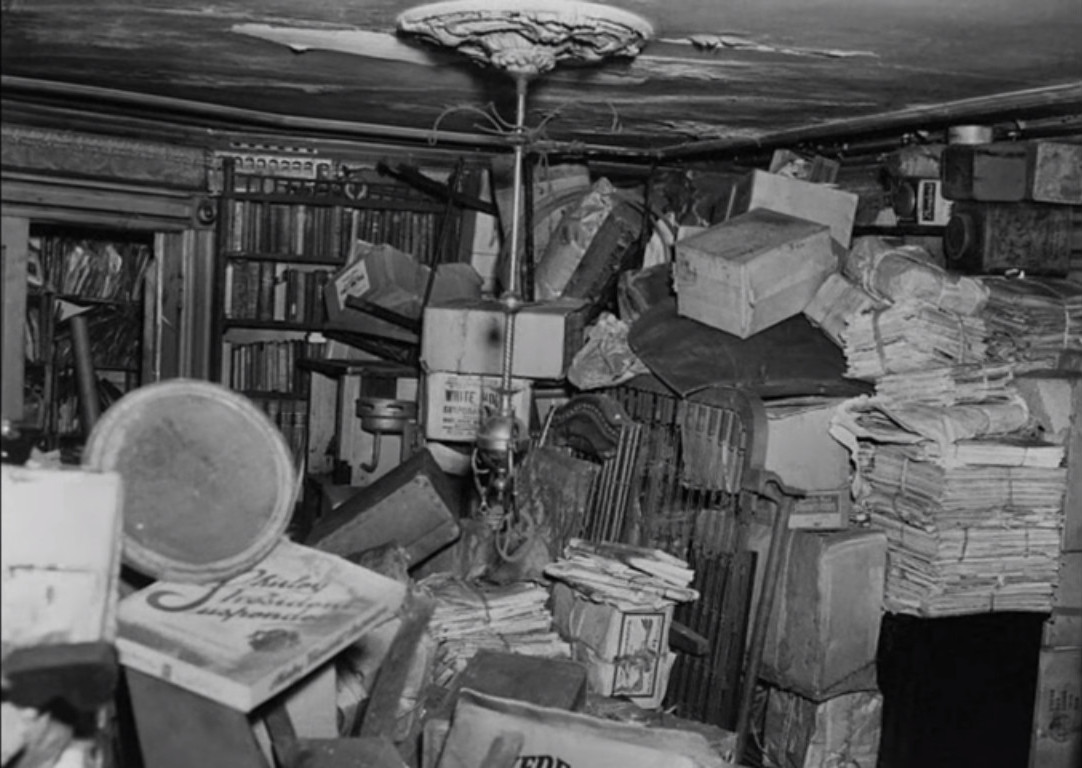193-The Collyer Brothers
Futility Closet
Greg Ross
4.8 • 748 Ratings
🗓️ 19 March 2018
⏱️ 32 minutes
🧾️ Download transcript
Summary

In the 1930s, brothers Homer and Langley Collyer withdrew from society and began to fill their Manhattan brownstone with newspapers, furniture, musical instruments, and assorted junk. By 1947, when Homer died, the house was crammed with 140 tons of rubbish, and Langley had gone missing. In this week's episode of the Futility Closet podcast we'll tell the strange, sad story of the Hermits of Harlem.
We'll also buy a bit of Finland and puzzle over a banker's misfortune.
Intro:
When New Amsterdam governor Wilhelm Kieft tried to outlaw smoking in the 1630s, his citizens literally puffed him into submission.
Residents of the Canary island La Gomera communicate over long distances using a unique whistled language.
Sources for our feature on the Collyer brothers:
Franz Lidz, Ghosty Men, 2003.
Franz Lidz, "The Paper Chase," New York Times, Oct. 26, 2003.
William Bryk, "The Collyer Brothers," New York Sun, April 13, 2005.
Michael Kernan, "The Collyer Saga And How It Grew; Recalling the Men Who Turned Trash Into Legend," Washington Post, February 8, 1983, B1.
"Strange Case of the Collyer Brothers," Life, April 7, 1947.
Robert M. Jarvis, "The Curious Legal Career of Homer L. Collyer," Journal of Maritime Law and Commerce 38:4 (October 2007), 571-582.
Keith P. Ronan, "Navigating the Goat Paths: Compulsive Hoarding, or Collyer Brothers Syndrome, and the Legal Reality of Clutter," Rutgers Law Review 64:1 (Fall 2011), 235-266.
Kenneth J. Weiss, "Hoarding, Hermitage, and the Law: Why We Love the Collyer Brothers," Journal of the American Academy of Psychiatry and the Law 38:2 (June 2010), 251-257.
Kenneth J. Weiss and Aneela Khan, "Hoarding, Housing, and DSM-5," Journal of the American Academy of Psychiatry and the Law 43:4 (December 2015), 492-498.
Scott Herring, "Collyer Curiosa: A Brief History of Hoarding," Criticism 53:2 (Spring 2011), 159-188.
Patrick W. Moran, "The Collyer Brothers and the Fictional Lives of Hoarders," Modern Fiction Studies 62:2 (Summer 2016), 272-I.
Jackie McAllister, "The Collyer Brothers," Grand Street 14:2 (Fall 1995), 201.
Joyce Carol Oates, "Love and Squalor," New Yorker, Sept. 7, 2009.
"Collyer Mansion Keeps Its Secrets," New York Times, Sept. 30, 1942.
Harold Faber, "Homer Collyer, Harlem Recluse, Found Dead at 70," New York Times, March 22, 1947.
"Thousands Gape at Collyer House," New York Times, March 24, 1947.
Harold Faber, "Police Fail to Find Collyer in House," New York Times, March 25, 1947.
"The Collyer Mystery," New York Times, March 26, 1947.
"Collyer Mansion Yields Junk, Cats," New York Times, March 26, 1947.
"Langley Collyer Is Dead, Police Say," New York Times, March 27, 1947.
Russell Owen, "Some for O. Henry: Story of the Collyers," New York Times, March 30, 1947.
"3D Search Starts at Collyer House," New York Times, April 1, 1947.
"53 Attend Burial of Homer Collyer," New York Times, April 2, 1947.
"More Secrets Taken From Collyer Home," New York Times, April 4, 1947.
Harold Faber, "Body of Collyer Is Found Near Where Brother Died," New York Times, April 9, 1947.
"Langley Collier Dead Near Month," New York Times, April 10, 1947.
"200 Bid Spiritedly for Collyer Items," New York Times, June 11, 1947.
"Collyer Home 'Unsafe,'" New York Times, June 26, 1947.
"Collyer Brothers Park," Atlas Obscura (accessed March 4, 2018).
Andy Newman, "Origin Aside, 'Collyers' Mansion' Is Code for Firefighter Nightmare," New York Times, July 5, 2006, B1.
Listener mail:
Wikipedia, "Category:Drugs With Unknown Mechanisms of Action" (accessed March 16, 2018).
Wikipedia, "Theories of General Anaesthetic Action" (accessed March 16, 2018).
Wikipedia, "Paracetamol" (accessed March 16, 2018).
Tanya Lewis, "Mystery Mechanisms," The Scientist, July 29, 2016.
Bruce Schneier, "Harassment by Package Delivery," Schneier on Security, Feb. 22, 2018.
Sean P. Murphy, "'I Just Want It To Stop': Women Get Sex Toys In Packages They Didn't Order," Boston Globe, Feb. 20, 2018.
Sean P. Murphy, "This Couple Keeps Getting Mystery Packages From Amazon They Didn't Order," Boston Globe, Feb. 6, 2018.
"Bow Tie - Every Buyer Gets 100 Square Feet of Scandinavian Forest - Hand Made in Finland from Finnish Curly Birch - By Woodinavia," Amazon UK (accessed March 16, 2018).
This week's lateral thinking puzzle was contributed by listener Tommy Honton, who sent this corroborating link (warning -- this spoils the puzzle).
You can listen using the player above, download this episode directly, or subscribe on iTunes or Google Play Music or via the RSS feed at http://feedpress.me/futilitycloset.
Please consider becoming a patron of Futility Closet -- on our Patreon page you can pledge any amount per episode, and we've set up some rewards to help thank you for your support. You can also make a one-time donation on the Support Us page of the Futility Closet website. Many thanks to Doug Ross for the music in this episode.
If you have any questions or comments you can reach us at [email protected]. Thanks for listening!
Transcript
Click on a timestamp to play from that location
| 0:00.0 | Welcome to the Futility Closet Podcast, forgotten stories from the pages of history. |
| 0:13.9 | Visit us online to sample more than 10,000 quirky curiosities from a smoker's protest to a whistled language. |
| 0:20.6 | This is episode 193. I'm Greg Ross. |
| 0:23.5 | And I'm Sharon Ross. In the 1930s, brothers Homer and Langley Collier withdrew from society |
| 0:29.5 | and began to fill their Manhattan brownstone with newspapers, furniture, musical instruments, |
| 0:34.8 | and assorted junk. By 1947, when Homer died, the house was crammed |
| 0:39.9 | with 140 tons of rubbish, and Langley had gone missing. In today's show, we'll tell the strange, |
| 0:46.5 | sad story of the hermits of Harlem. We'll also buy a bit of Finland and puzzle over a banker's |
| 0:53.4 | misfortune. |
| 1:03.7 | At dawn on March 21st, 1947, someone called the New York Police Department and said there's a dead man at 2078 Fifth Avenue. He said there was a smell emanating from the house. When they |
| 1:08.8 | asked who had died, he said Homer Collier. |
| 1:16.2 | That wasn't entirely a surprise. Homer Collier had become a peculiar celebrity in 1940s, Manhattan, |
| 1:20.6 | and his death had been reported many times before, sending police repeatedly to the Collier House. |
| 1:24.8 | Today they arrived at about 10 a.m., a police inspector and about 15 patrolmen. |
| 1:30.8 | They knew they'd have trouble getting in. There was no doorbell or telephone. All the doors were bolted, and the basement windows were covered with iron grills. They chopped a hole in the front door, and they found what they knew they'd find, |
| 1:35.2 | a solid wall of junk, sawhorses, frying pans, umbrellas, bicycles, baby carriages, Christmas |
| 1:40.5 | trees, chandeliers, toys, and thousands of newspapers. For two hours, the police |
| 1:45.0 | tried to force their way into the first floor while a crowd began to gather behind them, |
| 1:48.5 | including newspaper reporters, photographers, and cameramen. In some sense, New York had been |
| 1:52.9 | waiting for this. Homer Collier and his brother Langley had lived in this three-story brownstone |
| 1:56.8 | for 38 years, and now had packed it almost solidly full of objects so that the only passage |
| 2:01.4 | to be found was through an elaborate network of tunnels. A little afternoon, the police gave up on |
... |
Please login to see the full transcript.
Disclaimer: The podcast and artwork embedded on this page are from Greg Ross, and are the property of its owner and not affiliated with or endorsed by Tapesearch.
Generated transcripts are the property of Greg Ross and are distributed freely under the Fair Use doctrine. Transcripts generated by Tapesearch are not guaranteed to be accurate.
Copyright © Tapesearch 2025.

